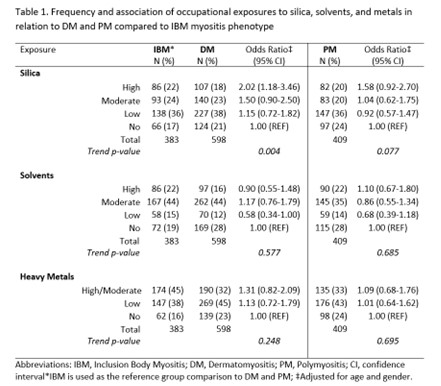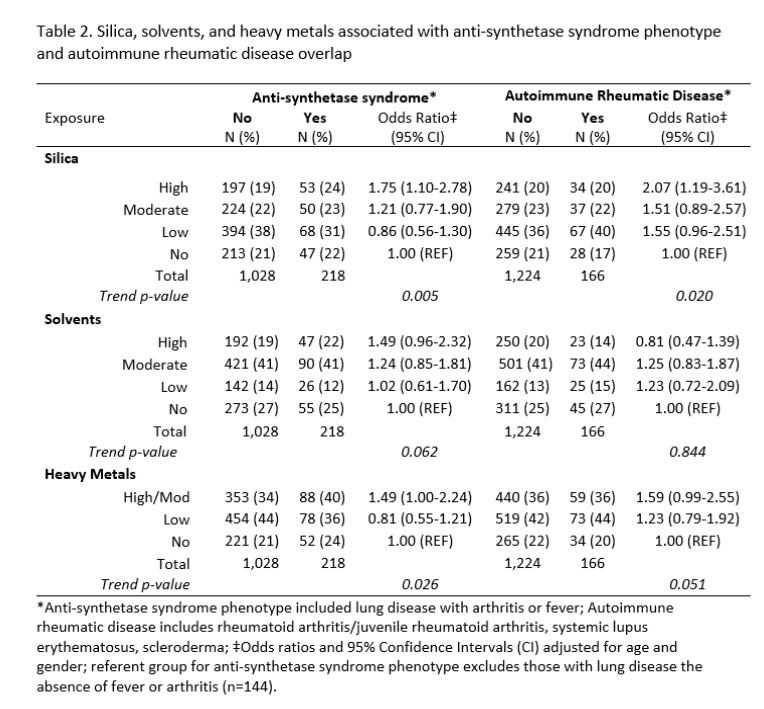Session Information
Session Type: Poster Session C
Session Time: 9:00AM-11:00AM
Background/Purpose: Growing evidence suggests that environmental factors may contribute to disease phenotype among patients diagnosed with the idiopathic inflammatory myopathies (IIM), dermatomyositis (DM), polymyositis (PM), and inclusion body myositis (IBM), as well as the anti-synthetase syndrome (SYN)-associated lung disease (LD). Occupational exposures, includingrespirable silica dust, have been associated with some systemic autoimmune diseases and lung disease, but associations with IIM phenotype are not well understood.
Methods: We analyzed data from 1390 adult IIM patients (ages 18-65) in a national patient registry (including 658 dermatomyositis [DM], 451 polymyositis [PM], and 309 inclusion body myositis [IBM]) diagnosed through 2011. Other phenotype data included self-reported lung involvement, fever, arthritis, and reported diagnosis of other autoimmune rheumatic diseases (ARD). A self-administered questionnaire asked about specific jobs, hobbies, longest held job (year started/stopped), and exposures prior to diagnosis. Responses were evaluated in a blinded expert review and rules-based assessment to assign exposure intensity with certainty ratings forrespirable silica dust (derived from quartz in rock, sand, or soil), solvents, and heavy metals prior to diagnosis. We examined exposure associations with (1) DM or PM vs. IBM, (2) LD+ fever or arthritis (SYN phenotype; N=218; 16%) vs. no LD (N=1028) and (3) comparing those with overlapping ARD (N=166; 12%) vs. no ARD (N=1224). We calculated odds ratios (OR) and 95% confidence intervals (CI) in logistic regression models adjusted for age and gender.
Results: High silica exposure was associated with increased odds of DM compared to IBM (OR 2.02; 95%CI 1.18, 3.46; p-trend=0.004 vs. unexposed), and the SYN phenotype (1.71; 1.07, 2.74; p-trend=0.005), which was also associated with high or moderate exposure to heavy metals (1.49; 1.00, 2.14; p-trend=0.026). High silica exposure was also associated with the ARD-overlap phenotype (2.07; 1.19, 3.61; p-trend=0.02) and the OR was elevated for high or moderate heavy metal exposure (1.59; 0.99, 2.55, p-trend=0.051). Associations limited to high certainty exposures were stronger for silica exposure and the DM, SYN, and ARD phenotypes, and for heavy metals and the SYN phenotype, and results were similar when limited to female participants.Solvent exposure was not associated with DM or PM (vs. IBM), or the SYN or ARD-overlap phenotypes.
Conclusion: These findings suggest that intense occupational exposure to respirable silica dust and exposure to heavy metals may contribute to distinctive disease phenotypes in adult IIM patients, including lung involvement, one of the more severe manifestations of IIM, and overlap with other ARD. Larger clinical studies, including rigorous exposure assessment, are warranted to identify high risk patients and investigate potential etiologies.
To cite this abstract in AMA style:
Parks C, Wilkerson J, Noroozi Farhad P, Bayat N, Schiffenbauer A, Brunner H, Goldberg R, Miller F, Rider L. Silica and Other Exposures from Jobs and Hobbies Are Associated with Myositis Phenotype in a National Myositis Registry [abstract]. Arthritis Rheumatol. 2023; 75 (suppl 9). https://acrabstracts.org/abstract/silica-and-other-exposures-from-jobs-and-hobbies-are-associated-with-myositis-phenotype-in-a-national-myositis-registry/. Accessed .« Back to ACR Convergence 2023
ACR Meeting Abstracts - https://acrabstracts.org/abstract/silica-and-other-exposures-from-jobs-and-hobbies-are-associated-with-myositis-phenotype-in-a-national-myositis-registry/


